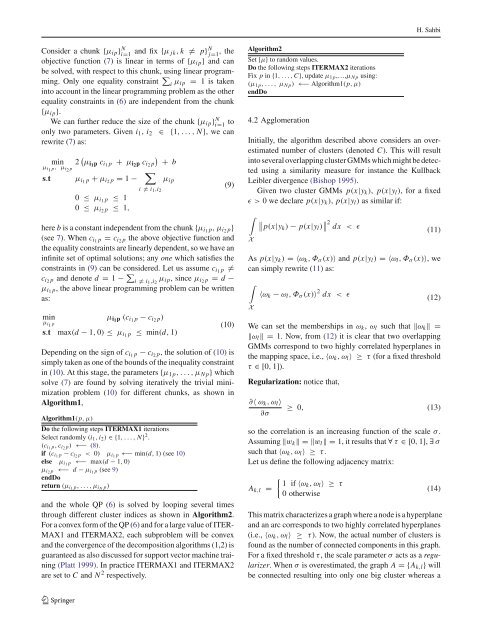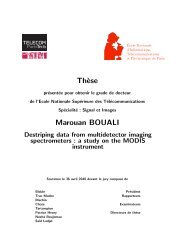A particular Gaussian mixture model for clustering and its ...
A particular Gaussian mixture model for clustering and its ...
A particular Gaussian mixture model for clustering and its ...
Create successful ePaper yourself
Turn your PDF publications into a flip-book with our unique Google optimized e-Paper software.
H. SahbiConsider a chunk {µ ip }i=1 N <strong>and</strong> fix {µ jk, k ̸= p} N j=1 ,theobjective function (7) is linear in terms of {µ ip } <strong>and</strong> canbe solved, with respect to this chunk, using linear programming.Only one equality constraint ∑ i µ ip = 1 is takeninto account in the linear programming problem as the otherequality constraints in (6) are independent from the chunk{µ ip }.We can further reduce the size of the chunk {µ ip }i=1 N toonly two parameters. Given i 1 , i 2 ∈ {1,...,N}, we canrewrite (7) as:min 2 ( µ i1 p c i1 p + µ i2 p c i2 p)+ bµ i1 p, µ i2 ps.t µ i1 p + µ i2 p = 1 − ∑µ ipi ̸= i 1 ,i 20 ≤ µ i1 p ≤ 10 ≤ µ i2 p ≤ 1,here b is a constant independent from the chunk {µ i1 p,µ i2 p}(see 7). When c i1 p = c i2 p the above objective function <strong>and</strong>the equality constraints are linearly dependent, so we have aninfinite set of optimal solutions; any one which satisfies theconstraints in (9) can be considered. Let us assume c i1 p ̸=c i2 p <strong>and</strong> denote d = 1 − ∑ i ̸= i 1 ,i 2µ ip , since µ i2 p = d −µ i1 p, the above linear programming problem can be writtenas:minµ i1 p (c i1 p − c i2 p)µ i1 ps.t max(d − 1, 0) ≤ µ i1 p ≤ min(d, 1)(9)(10)Depending on the sign of c i1 p − c i2 p, the solution of (10) issimply taken as one of the bounds of the inequality constraintin (10). At this stage, the parameters {µ 1p ,...,µ Np } whichsolve (7) are found by solving iteratively the trivial minimizationproblem (10) <strong>for</strong> different chunks, as shown inAlgorithm1,Algorithm1(p,µ)Do the following steps ITERMAX1 iterationsSelect r<strong>and</strong>omly (i 1 , i 2 ) ∈{1,...,N} 2 .(c i1 p, c i2 p) ←− (8).if (c i1 p − c i2 p < 0) µ i1 p ←− min(d, 1) (see 10)else µ i1 p ←− max(d − 1, 0)µ i2 p ←− d − µ i1 p (see 9)endDoreturn (µ i1 p,...,µ iN p)<strong>and</strong> the whole QP (6) is solved by looping several timesthrough different cluster indices as shown in Algorithm2.For a convex <strong>for</strong>m of the QP (6) <strong>and</strong> <strong>for</strong> a large value of ITER-MAX1 <strong>and</strong> ITERMAX2, each subproblem will be convex<strong>and</strong> the convergence of the decomposition algorithms (1,2) isguaranteed as also discussed <strong>for</strong> support vector machine training(Platt 1999). In practice ITERMAX1 <strong>and</strong> ITERMAX2are set to C <strong>and</strong> N 2 respectively.Algorithm2Set {µ} to r<strong>and</strong>om values.Do the following steps ITERMAX2 iterationsFix p in {1,...,C}, update µ 1p ,…,µ Np using:(µ 1p ,..., µ Np ) ←− Algorithm1(p,µ)endDo4.2 AgglomerationInitially, the algorithm described above considers an overestimatednumber of clusters (denoted C). This will resultinto several overlapping cluster GMMs which might be detectedusing a similarity measure <strong>for</strong> instance the KullbackLeibler divergence (Bishop 1995).Given two cluster GMMs p(x|y k ), p(x|y l ),<strong>for</strong>afixedɛ>0 we declare p(x|y k ), p(x|y l ) as similar if:∫X∥ p(x|yk ) − p(x|y l ) ∥ ∥ 2 dx < ɛ(11)As p(x|y k ) =〈ω k ,Φ σ (x)〉 <strong>and</strong> p(x|y l ) =〈ω l ,Φ σ (x)〉, wecan simply rewrite (11) as:∫X〈ω k − ω l ,Φ σ (x)〉 2 dx < ɛ(12)We can set the memberships in ω k , ω l such that ‖ω k ‖=‖ω l ‖=1. Now, from (12) it is clear that two overlappingGMMs correspond to two highly correlated hyperplanes inthe mapping space, i.e., 〈ω k ,ω l 〉 ≥ τ (<strong>for</strong> a fixed thresholdτ ∈[0, 1]).Regularization: notice that,∂〈 ω k ,ω l 〉∂σ≥ 0, (13)so the correlation is an increasing function of the scale σ .Assuming ‖w k ‖=‖w l ‖=1, it results that ∀ τ ∈[0, 1], ∃ σsuch that 〈ω k ,ω l 〉 ≥ τ.Let us define the following adjacency matrix:A k,l ={ 1 if〈ωk ,ω l 〉 ≥ τ0 otherwise(14)This matrix characterizes a graph where a node is a hyperplane<strong>and</strong> an arc corresponds to two highly correlated hyperplanes(i.e., 〈ω k ,ω l 〉 ≥ τ). Now, the actual number of clusters isfound as the number of connected components in this graph.For a fixed threshold τ, the scale parameter σ acts as a regularizer.When σ is overestimated, the graph A ={A k,l } willbe connected resulting into only one big cluster whereas a123















